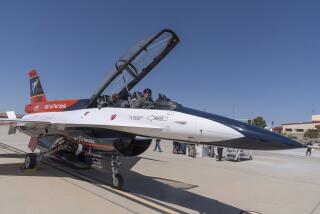He Engineered Dominance of the Skies
- Share via
In 1945, Clarence “Kelly” Johnson was more or less given orders to save the “Free World.”
World War II had concluded, giving way to the turmoil of the Cold War. If the United States was to remain superior to the Soviet Union, it was up to Johnson, an aeronautical engineer at Lockheed’s plant in Burbank, to build the next generation of military aircraft.
Johnson was loud, demanding and brilliant. His secret team, whose headquarters came to be known as the “Skunk Works,” pushed aircraft to new limits. First, Johnson’s team refined the P-80, America’s first operational jet fighter. Next, in 1954, came the XF-104, the first fighter plane capable of flying at twice the speed of sound. One year later, in 1955, the Skunk Works produced the U2 spy plane, which flew at previously unheard of altitudes.
There were no spy satellites at the time and the U2 allowed the United States to get a much-needed glimpse into what was going on behind the Iron Curtain. The U2 also led to one of the great diplomatic crises of the Cold War, when a U2 was shot down over Soviet airspace in 1960. The Soviets did not release the U2’s pilot, Francis Gary Powers, until 1962.
The Skunk Works eventually moved to Palmdale, where Johnson’s successor, Ben Rich, developed the stealth fighter.
Johnson, arguably the most important man in the history of military aircraft, retired in 1975 and died in 1990.
More to Read
Inside the business of entertainment
The Wide Shot brings you news, analysis and insights on everything from streaming wars to production — and what it all means for the future.
You may occasionally receive promotional content from the Los Angeles Times.










